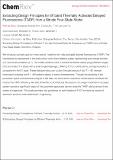Extracting Design Principles for Efficient Thermally Activated Delayed Fluorescence (TADF) from a Simple Four-State Model
Author(s)
de Silva, Piotr; Kim, Changhae Andrew; Zhu, Tianyu; Van Voorhis, Troy
DownloadSubmitted version (1.876Mb)
Publisher Policy
Publisher Policy
Article is made available in accordance with the publisher's policy and may be subject to US copyright law. Please refer to the publisher's site for terms of use.
Terms of use
Metadata
Show full item recordAbstract
We introduce a simple quantum-mechanical model for thermally activated delayed fluorescence (TADF). The Hamiltonian is represented in the basis of four spin-mixed diabatic states representing pure charge transfer (CT) and local excitations (LE). The model predicts that it is possible to realize lowest-lying adiabatic singlet (S1) and triplet (T1) states with a small singlet-triplet gap, differing CT/LE contributions, and appreciable LE component in the S1 state. These characteristics can explain the coexistence of fast T1 → S1 reverse intersystem crossing and S1 → S0 radiative decay in some chromophores. Through the sampling of the parameter space and statistical analysis of the data, we show which parameter combinations contribute the most to the TADF efficiency. We also show that conformational fluctuations of a single model donor-acceptor system sample a significant region of the parameter space and can enhance the TADF rate by almost 3 orders of magnitude. This study provides new guidelines for optimization of TADF emitters by means of electronic structure and conformation engineering.
Date issued
2019-06Department
Massachusetts Institute of Technology. Department of ChemistryJournal
Chemistry of materials
Publisher
American Chemical Society (ACS)
Citation
Silva, Piotr de et al. “Extracting Design Principles for Efficient Thermally Activated Delayed Fluorescence (TADF) from a Simple Four-State Model.” Chemistry of materials 31 (2019): 6995-7006.
Version: Original manuscript
ISSN
0897-4756